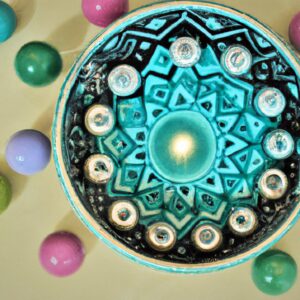Introduction to Feng Shui
Feng Shui is an ancient Chinese practice that seeks to create harmony between the environment and the individuals living within it. Its origins date back thousands of years, with its philosophy based on the concept of Qi (or “life energy”). According to Feng Shui, Qi can be manipulated through the arrangement of objects in a space. Therefore, by rearranging items in a home, one can seek to improve the quality of life.
Creating a harmonious home through Feng Shui is not simply about decorating or rearranging furniture. It is more than that – it is about creating balance both inside and outside the home. This balance is achieved by working with the environment surrounding the home, as well as making careful choices for the interior. Through the use of Feng Shui, one can increase good luck, reduce anxiety, and ultimately create a more peaceful and harmonious home.
History of Feng Shui
Some believe that Feng Shui dates back to more than 3,000 years ago in ancient China. During that time, it was used to describe the interconnection between human beings and their environment. Over the centuries, this Chinese practice developed into a method for creating harmony in the home.
Common practices in early cultures included placing plants and water features in a home as well as using sand and special stones to create patterns. This was thought to create energy and a balanced atmosphere. Sunlight and fresh air were also important components; these were thought to help create an atmosphere of vitality and well-being.
In later centuries, Feng Shui grew in popularity and a set of rules were developed to govern the placement of furniture and objects within the home. The aim of these rules was to create positive energy and a harmonious atmosphere. The practice reached its peak of popularity during the Ming dynasty (1368–1644) when it was adopted by the Royal Court. Today, Feng Shui is still widely practiced and has become increasingly popular in the West.
Overview of the Five Element Theory
The Five Element Theory is a core principle of Feng Shui and has been used to promote harmony for centuries. This theory states that everything in life can be divided into five different elements, which are fire, earth, metal, water, and wood. Each element is associated with certain characteristics, such as color, shape, energy, and sound.
These five elements must be in balance in order to create a harmonious home. For instance, the placement of objects in a room dictates how these elements interact with each other. If the elements are out of balance, the result can be negative energy that can lead to disharmony or misfortune.
In order to restore the balance, there are several related practices to help bring harmony back to the home. For example, one practice is to arrange furniture, artwork, and decorations in certain areas of the house to cultivate a favorable energy flow. There are also techniques for utilizing the colors and shapes associated with the five elements, as well as using music and aromas.
Overall, by understanding the Five Element Theory and applying it to the living environment, a harmonious home can be created. With the proper arrangement of elements, balance and harmony can be achieved.
Overview of the Bagua Map
The Bagua Map is a tool used in Feng Shui to measure and create balance and harmony. It is based on the eight trigrams found in the I-Ching, one of China’s oldest books of divination and spiritual guidance.
The Bagua translates to “eight directions” and each trigram covers one area of the home. Each triangle includes one of the five elements—earth, fire, wood, water, and metal—which are connected to different aspects of life, such as relationships, career, prosperity, and health. When the Bagua Map is placed over your home it creates a grid with each trigram represented by its own element.
The Bagua Map can be used to identify areas within the home where there is an imbalance. Once an imbalance has been identified, it is possible to make adjustments in order to bring greater balance and harmony. This could include rearranging furniture, introducing décor pieces that match the element of the trigram, or using colors that correspond to the element representing the trigram.
Although the Bagua Map is traditionally used for residential properties, it can also be applied to any space, including offices, commercial buildings, and even gardens.
Working with the Environment
When practicing Feng Shui, it’s important to consider the environment outside of the home as well as the interior. The energy from the natural elements and surrounding environment can have a positive or negative effect on the wellbeing of those living in the home. Therefore, it is essential to create a harmonious balance between the environment and the home.
One of the first steps when working with the environment is to observe the land around the property. Is there a nearby river or stream? Are there large trees that could provide shade and promote feelings of relaxation? All of these observations can help to create a more harmonious space.
Design elements such as pathways, steps, terraces, and ponds can be used to promote movement of energy, while water features such as waterfalls, streams, and fountains can help to facilitate the flow of energy. Adding plants and flowers to the garden can boost the energy levels and promote a peaceful atmosphere. Additionally, it may be beneficial to create separate outdoor areas for entertaining and relaxation to encourage more harmony in the home.
Finally, it is important to keep in mind that the land surrounding the home should not be left neglected. Regular maintenance tasks such as mowing the lawn and trimming hedges can help to reduce any negative energy and create a more harmonious atmosphere.
Working with the Interior
Making changes to the interior of your home is a great way to incorporate the principles of Feng Shui into your life. The main idea behind this is to create an environment that is pleasing to the eye and that promotes balance and harmony in your home. Here are some tips on how you can use Feng Shui to arrange and decorate the interior of your home:
- Choose colors that bring balance and harmony. Look for colors that are calming, such as blues and greens, as well as energizing, such as yellows and reds.
- Create pathways that direct energy in a positive direction. Hang pictures in areas that are open and inviting and place furniture in a way that encourages conversation and connection.
- Keep your living space clean and organized. Clutter can create a feeling of chaos and imbalance, so keep it to a minimum and make sure everything has a place.
- Place items of importance in the areas of the home that correspond to the Bagua. This can help activate specific areas and bring balance to the home.
By taking these steps and incorporating the principles of Feng Shui into your home, you can create an environment that is balanced and harmonious.
Meditation Practices
Meditation is an essential component of Feng Shui, helping to promote balance and harmony in the home. There are various techniques that can be used, such as mindfulness meditation, guided meditation, and visualization. Mindfulness meditation involves focusing on your breath, paying attention to the present moment without judgement. Guided meditation helps to focus the mind on specific goals or intentions, allowing you to tap into your inner power. Visualization involves mentally constructing a vision for what you would like to manifest in your home.
The goal of meditation in Feng Shui is to create a calm, peaceful environment in which to conduct your practice. Select a spot in your home that feels comfortable – it may be in your bedroom, living room, or even outside. Gather any items that you may need for meditation, such as a cushion, incense, candles, and a journal. Begin by sitting in a comfortable position, closing your eyes, and taking several long, deep breaths. Follow the breath, slowly and steadily throughout the duration of the meditation.
When engaging in meditation with Feng Shui, it is important to focus on intention setting and visualization. Take time to consider the kinds of intentions that you would like to set for yourself and your home. Visualize these intentions, imagining them as becoming reality. This will help to bring about the positive changes that you desire in your home and in your life.
Feng Shui meditation can be a powerful tool for enhancing balance and harmony in the home. For optimal results, dedicate time and energy to regular meditation practices. With consistent and mindful effort, you can create a harmonious home that reflects your own unique energy.
Conclusion
Feng Shui is an ancient art with a rich history that teaches us how to create harmony within ourselves, our homes, and our environment. By understanding the principles of the Five Element Theory, the Bagua Map, and how to work with the environment and interior of a home, we can use Feng Shui practices to create an atmosphere of peace and tranquility. Whether it is through meditation, rearranging furniture, or supplementing the elements in the home, Feng Shui gives us the tools to create balance and harmony in our lives. By implementing the principles of this ancient art, we can make significant changes in our homes and give ourselves the opportunity to lead a more harmonious life.
comments: 0



